|
Family: Cuculidae (Old World cuckoos)
Life
> Eukaryotes >
Opisthokonta
> Metazoa (animals) >
Bilateria >
Deuterostomia > Chordata >
Craniata > Vertebrata (vertebrates) > Gnathostomata (jawed
vertebrates) > Teleostomi (teleost fish) > Osteichthyes (bony fish) > Class:
Sarcopterygii (lobe-finned
fish) > Stegocephalia (terrestrial
vertebrates) > Tetrapoda
(four-legged vertebrates) > Reptiliomorpha > Amniota >
Reptilia (reptiles) >
Romeriida > Diapsida > Archosauromorpha > Archosauria >
Dinosauria
(dinosaurs) > Saurischia > Theropoda (bipedal predatory dinosaurs) >
Coelurosauria > Maniraptora > Aves
(birds) > Order: Cuculiformes
Species indigenous to southern Africa
|
Cercococcyx montanus (Barred long-tailed
cuckoo, Barred cuckoo) |
|
|
Ceuthmochares aereus (Green
malkoha,
Green coucal)
The Green malkoha occurs in band extending across eastern
sub-Saharan Africa, from Kenya to Mozambique and KwaZulu-Natal. It usually
prefers dense thickets at forest edges, avoiding the middle of the forest. It
mainly eats insects and small vertebrates, usually foraging in dense vegetation
but occasionally emerging to catch termite alates or caterpillars. It is
probably monogamous, nesting in a flimsy platform of twigs and plant detritus,
usually concealed in thick vegetation. There is little more information about
its breeding habits, as there have been no large studies done on this species. |
 |
|
Chrysococcyx caprius (Diderick
cuckoo) The Diderick cuckoo is common in large
areas of southern Africa, and lives in wide variety of habitats. It feeds
exclusively on invertebrates, especially caterpillars. As it is a brood
parasite, it lays its eggs in other birds nests, laying 1 per nest but 22-24
in the whole breeding season. It destroys any eggs that the host has laid,
before laying 1 egg, after which it leaves and is often mobbed by the host.
The chick eats the other eggs or chicks that its parent didn't remove, in
the first 3 days. It stays in the nest for about 19-22 days, after which the
chick remains with its host parents for about 21 more days. |
 |
|
Chrysococcyx cupreus (African emerald
cuckoo, Emerald cuckoo) |
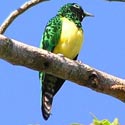 |
|
Chrysococcyx klaas (Klaas's cuckoo) The Klaas's
cuckoo is fairly common across sub-Saharan Africa, absent only from arid
desert, usually occupying broad-leaved woodland. It is mainly insectivorous,
specializing in butterflies and caterpillars. It is a brood parasite,
meaning that it lays its eggs in other birds nests. The host, thinking that
the egg is its own, incubates the egg, and cares for the chick. It lays 1
egg per nest, laying roughly 24 eggs in one breeding season. The
chicks usually hatch after an incubation period of about 11-12 days. Soon
after hatching, the chick evicts any of the host's chicks or eggs that are
present in the nest. It stays in the nest for about 19-21 days, after which
it remains with the host bird for up to 25 days. |
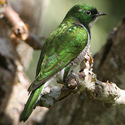 |
|
Clamator glandarius (Great spotted
cuckoo) The Great-spotted cuckoo is fairly common across its
scattered range, living in savannas and grasslands. It feeds on a wide variety
of invertebrates, rarely eating reptiles. It only parasitizes crows and
starlings, waiting until the host is not present, before laying 1-4
eggs into its nest. It lays up to 6 eggs in one day, and up to 23 in the whole
season. Unlike some cuckoos, the chicks do not always kill their "siblings", but
will sometimes peck and damage them. It stays in the nest for 22-26 days, the
period after this has not been studied. Interestingly, an adult cuckoo was once
recorded feeding a fledgling. |
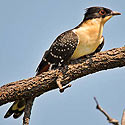 |
|
Clamator jacobinus (Jacobin cuckoo)
The Jacobin cuckoo is fairly common and widespread, with a occurring from
India to Arabia south to large areas of southern Africa. It is a specialist, feeding mainly on
caterpillars, foraging by hopping from branch to branch, snatching insects from
the foliage. It is a brood parasite, laying its eggs in other birds nests
(usually bulbuls). It lays 1 egg per nest,
laying a total of about 25 eggs in one breeding season. The chick hatches
after an incubation period of about 11-13 days, remaining in the nest for
roughly 17 days. It learns to fly soon after leaving, becoming fully
independent at about 33 days old. |
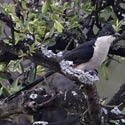 |
|
Clamator levaillantii (Levaillant's
cuckoo, Striped cuckoo) The Levaillant's cuckoo
occurs in huge areas of sub-Saharan Africa, preferring Acacia, miombo
and broad-leaved Burkea woodland. It is extremely secretive and hard to
find, foraging in thick undergrowth. It almost exclusively parasitizes
babblers, for reasons not
understood. Egg-laying is an elaborate process, with the male distracting
the host birds, while the female sneaks into the nest to lay its egg.
Unlike many other cuckoos, the chick does not kill the host nestlings, in
fact they often co-exist quite peacefully. The chick stays in the nest for
about 9-10 days, becoming fully independent 3-5 weeks later. |
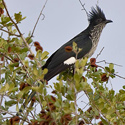 |
|
Cuculus canorus (Common cuckoo,
European cuckoo) |
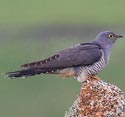 |
|
Cuculus clamosus (Black cuckoo)
The Black cuckoo is common and widespread, occurring throughout sub-Saharan
Africa, preferring relatively thick forest and Acacia woodland. Its
diet consists mostly of insects, especially caterpillars, but it also eats
the eggs and sometimes chicks of its host. It almost exclusively parasitizes
shrikes and boubous, especially of the Laniarius genus.
It lays eggs in "clutches" of 4, one laid
every 2 days. In total, the female can lay around 22 eggs in one breeding
season. A few days after hatching, the chick removes any existing eggs in
the host's nest. It stays in the nest for about 20-21 days, becoming fully
independent at around 39-64 days old. |
 |
|
Cuculus gularis (African cuckoo)
The African cuckoo occupies huge areas of sub-Saharan
Africa, absent from parts of the DRC, Somalia, South Africa and Namibia. It
usually occurs in open woodland and Acacia savanna, mostly eating
caterpillars. It exclusively parasitizes
Fork-tailed drongos: the
male distracts them whilst the female flies in to the nest, removes any
existing eggs before laying one of its own. Soon after hatching, the chick
removes any existing Drongo eggs or chicks in the nest, remaining in the
nest for about 23 days before leaving. |
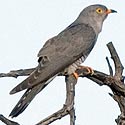 |
|
Cuculus poliocephalus (Lesser cuckoo)
|
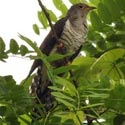 |
|
Cuculus rochii (Madagascar cuckoo) |
s.jpg) |
|
Cuculus solitarius (Red-chested cuckoo)
The Red-chested cuckoo is mainly found in the eastern half
of southern Africa, and is quite common in protected areas, living in a wide
range of habitats. It feeds mostly on invertebrates, particularly hairy caterpillars but
also grasshoppers and beetles, amongst others. It mostly parasitizes members of
Muscicapidae (robins, thrushes,
flycatchers, etc.), rushing into their nests,
and removing the host's eggs before laying one of its own, all in just 5
seconds! Once the chick is 2 days old, it evicts the host's eggs and nestlings.
It stays in the nest for 17-21 days, and is dependent on its host
parents for 20-25 days more, before becoming fully independent. |
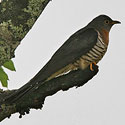 |
|
Pachycoccyx audeberti (Thick-billed
cuckoo) |
|
|
